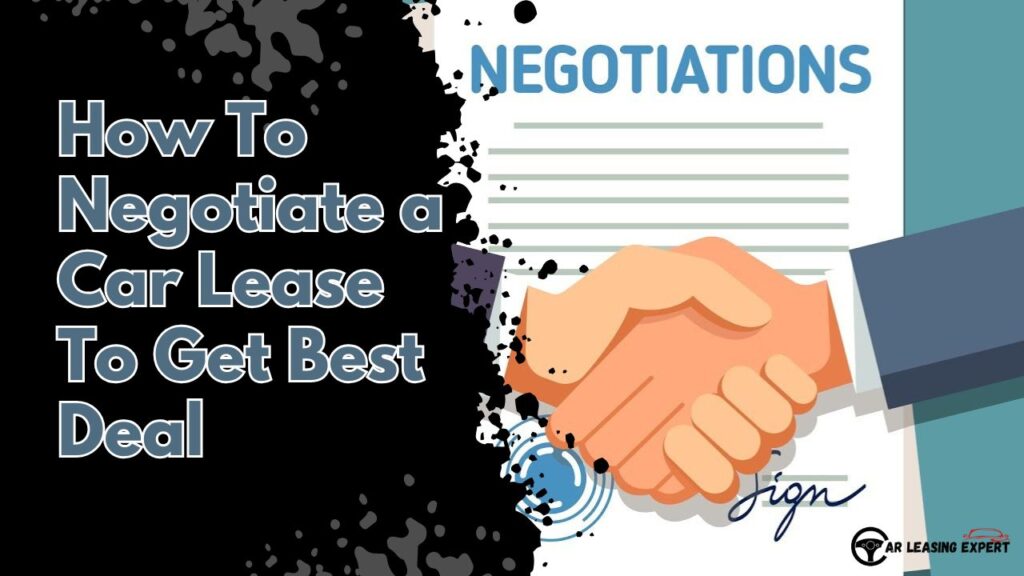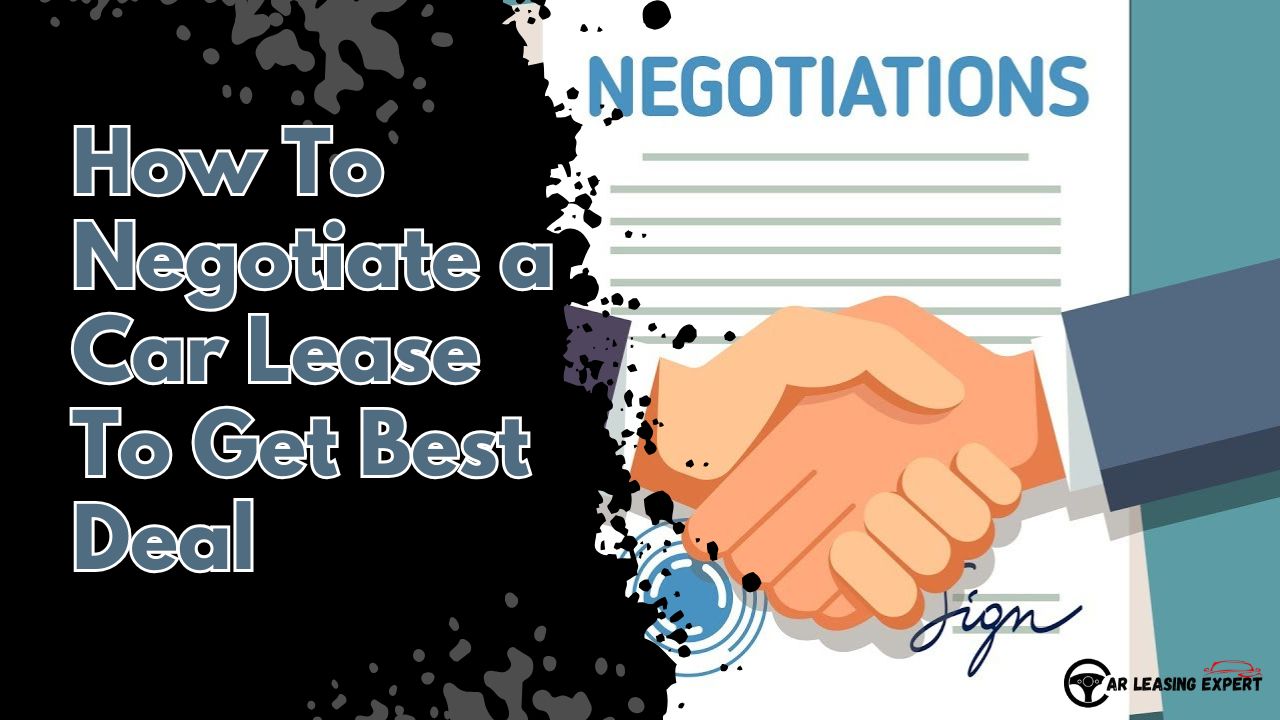How To Negotiate a Car Lease To Get Best Deal? Many people who have leased a car have paid much more than they should have for it. However, you may not want to commit to buying a car with a car loan from a lender or at the high cost of buying it outright. That’s why leasing a new car can be a great alternative.
One of the reasons people like to buy cars is to haggle and negotiate the price with the salesperson. However, there are aspects of leasing a car that you can negotiate to try to get the best deal possible. Comparing and exploring special offers from various dealers is another valuable step to help you negotiate a reliable car lease, ensuring you get the best possible rental for your needs.
Knowing how to negotiate a car lease can be a useful skill, especially if you understand some of the terms of the contract. This isn’t always the case with rental contracts, but you can follow this step-by-step approach to negotiating a car lease.
Can You Negotiate a Car Lease?
Many people ask us that can i negotiate a car lease?
The answer is yes. You can negotiate a car lease, including the down payment, rental fee, and acquisition fees. You can also negotiate mileage on lease agreements.
What Is Negotiable With Car Leases
When renting a car, several aspects can be negotiated to better fit your needs and budget. Here are some important aspects that are often negotiable in car rental contracts:
1. Capitalized cost (cap cost)
Cap cost is the negotiated selling price of the car. Just like when you buy a car, you can negotiate this amount to lower the total cost of the lease.
2. Down payment
The down payment, or cap cost reduction, can be negotiated. You may be able to reduce or eliminate the down payment, depending on the rental company’s policies.
3. Monthly payments
Monthly payments are influenced by the cap cost, the interest rate (money factor), and the term of the lease. By negotiating a lower cap cost or a lower money factor, you can lower your monthly payments.
4. Money factor
The money factor is the interest rate on the lease. While it’s usually set by the rental company, it’s sometimes negotiable, especially if you have a good credit rating.
5. Lease Term
The length of the lease contract can be negotiated (typically 24, 36, or 48 months). A longer term can lower monthly payments, but could increase the overall cost due to expanded finance charges.
6. Mileage Limit
Most lease contracts include a fixed mileage limit (for example, 10,000, 12,000, or 15,000 miles per year). You can negotiate a higher mileage limit if you anticipate driving more than the standard amount.
7. Wear and Tear
The terms of what constitutes excessive wear and tear can sometimes be negotiated. This can help reduce the charges you might face when returning the car.
8. Purchase Option
Many lease contracts include a purchase option at the end of the lease term. You can negotiate the purchase price, which will allow you to buy the car at a lower cost if you decide to keep it.
9. Fees
Some fees, such as acquisition fees, disposition fees, and early termination fees, may be negotiable. It’s worth discussing these with the leasing company to see if they can be reduced or waived.
What You Can’t Negotiate in a Car Lease?
You may not be able to negotiate the residual value in your lease agreement. The residual value is what the leasing company estimates the car will be worth at the end of the lease term.
Another thing you may not be able to negotiate is the penalty for default. Failing to make required lease payments when they are due can result in repossession of the vehicle.
Here are some things you generally cannot negotiate in a car lease agreement:
- Manufacturer’s Suggested Retail Price (MSRP)
- Residual Value
- Interest rate
- Fees such as acquisition fees, disposition fees, and early termination fees
- State and Local Taxes
- Term length (24, 36, or 48 months) and standard lease conditions
6 Tips To Negotiate a Car Lease

1. Firstly, Know the Lease Terminology
Car leasing has a few different terms than the language used to buy or sell a car. For example, instead of a buyer and a seller, there is a lessor (the company that lease the vehicle) and a lessee (the person who enters into the lease agreement). Typically, lessees prefer a closed-end lease, meaning one in which the two parties agree (from the start of the contract) on an estimate of the car’s future value. Therefore, if the lease ends and the lessee returns the vehicle, they will not owe any more money for depreciation, even if the car is worth less than estimated in the original contract.
Residual value/future value is an estimate provided by the lessor to indicate how well a car is likely to hold its value over the rental period. A short-term car lease can last between 12 and 24 months, while a long-term lease can last up to 60 months.
Other terms you’ll likely hear include:
Lease Acquisition Fee – This is like an origination fee for a mortgage loan. It’s an upfront fee that covers the cost of checking your credit score, setting up the lease, etc.
Lease Disposition Fees – These fees may be charged if you return the car and are intended to cover the costs of getting the car into resale condition.
Rental Fee – This is similar to the interest paid on a car loan. The rental fee is part of the monthly fee you pay as a privilege to drive the leased car.
If you’re ever unsure about what a term means, ask or do your research. You can’t negotiate without understanding the terms of the discussion.
2. Research, Compare, Conquer
Before you head to the dealership, it’s good to research the available lease deals for the models you’re interested in. Look for manufacturer incentives and advertised specials as a starting point for your negotiations.
Be sure to check the typical selling price of the cars you want. Even if you’re not buying a new car, you can still negotiate the price. The lower you negotiate the price, the less depreciation you’ll have to pay over the life of the lease if all other terms remain the same. That can also mean a lower monthly lease payment.
You can easily use Lease Calculator Tool to calculate your monthly lease amount.
3. Maintain an Excellent Credit Rating
People with excellent credit ratings always have more leverage in negotiations, whether they’re leasing a new car or buying a used car from a dealer. Before you start looking at cars, you should do everything you can to improve your credit rating. Most of the time, lease deals and incentives will only be available to highly qualified lessees, which means your credit rating needs to be very good to take advantage of them. Additionally, dealers will be much more willing to negotiate if they can be sure that you will make payments on time and not cause them any problems.
4. Negotiate the sales price
The best way to get a deal on a lease is to not mention that you want to lease the car in the first place. While it may seem dishonest, it is an incredibly common negotiation tactic that can help you save quite a bit on the final price. Since the cap cost is a negotiable term of a lease, start by lowering the overall price of the car and then you can tell the salesperson that you want to lease the car. This way, you have the advantage of knowing how far the dealer is willing to go on the cap cost and they won’t be able to back out on that figure just because you want to lease the car.
5. Know your mileage needs
Negotiating lower mileage limits is a great way to get some money out of your lease payments, but if you go over the limit, you can end up paying a lot more. It’s important to know exactly how many miles you need each year and make sure you don’t negotiate a limit that’s less than you need. Your best bet is to track your mileage for two months and then multiply that number by six to get your annual average. Most lease agreements include between 10,000 and 10,500 miles per year. If you’re sure you won’t need that much, you can lower that limit and possibly save some money on the total cost of the lease.
6. Read the Fine Print Carefully
Lease agreement terms can vary by dealer and contract, and it’s important to be clear about what you’re agreeing to in yours.
In general, a lease is similar to a car lease, but for a longer period of time, usually two to four years. You’ll pay to use that car for the agreed-upon period of time and then, at the end, you’ll buy or return the car.
A typical lease agreement allows you to put between 10,000 and 15,000 miles on the vehicle each year. If you go over those limits, a per-mile fee is often charged.
7. Look at the build date
This is different from the model year. The older the build date, the longer the vehicle has been on a lot. For example, a car may be a 2023 model but have been manufactured in 2022. To get this information, look at the vehicle identification number, or VIN. The 10th digit will indicate the build date, and different manufacturers use different systems to indicate what that means.
8. Timing is everything
Strategically plan your lease negotiation during periods when dealers are eager to meet sales targets, such as the end of the month or the close of a financial quarter. During these periods, dealers may be more willing to reduce prices or include additional benefits.
9. Keep your trade-in separate
If you’re trading in a car, don’t let the dealer include it in the lease agreement. You should ask them to do the trade-in separately from the lease, just as if you had brought the car in to sell it. Then, ask them to apply whatever they offer you toward the maximum cost of the leased car. This ensures that there are no missed opportunities to have money taken off the cost of the new car and that you get the actual value of your trade-in, rather than a portion due to fees or other items that may be hidden within the lease.
Conclusion
Leasing a car is a great way to enjoy the convenience and security of a new car without the hassle and commitment of a car loan. If you want to save as much money as possible on your new vehicle, negotiating better terms or a lower cost of capital is a great option. Not only can you pay less for the car, but it can also make the entire process much easier. If you know what is negotiable with a lease and how you can go about it, you can save yourself some money in the long run.




